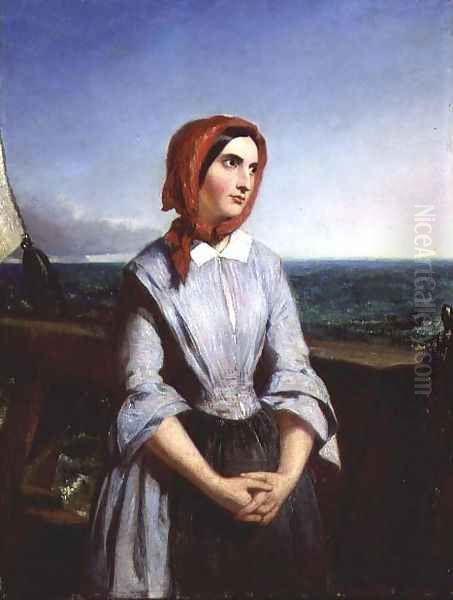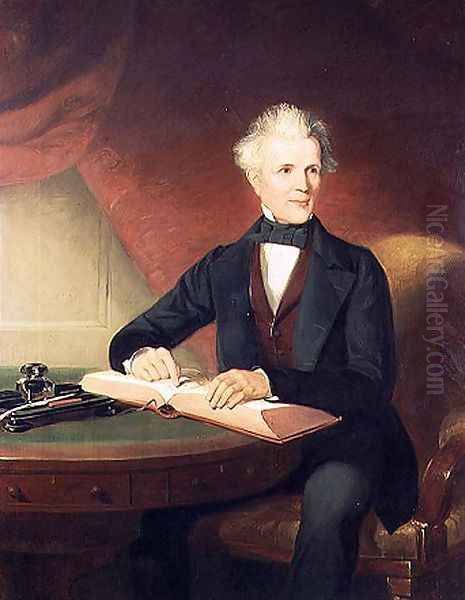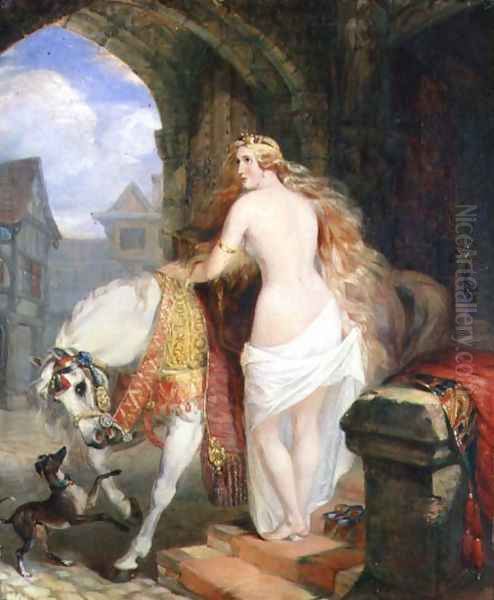Marshall Claxton (1811-1881) stands as a notable, if sometimes overlooked, figure in the landscape of 19th-century British art. A painter of considerable talent and ambition, his career was marked by extensive travels that took him from the established art centres of Europe to the burgeoning colonies of Australia and the vibrant cultures of India and Egypt. Claxton's oeuvre, primarily consisting of portraits, historical scenes, and religious subjects, reflects both the prevailing tastes of the Victorian era and the unique experiences he gathered on his global peregrinations. His life and work offer a fascinating window into the artistic currents of his time, the challenges and opportunities faced by artists seeking patronage, and the burgeoning global connections of the British Empire.
Early Life and Artistic Formation
Born in Bolton, Lancashire, England, around 1811 (some sources suggest 1812), Marshall Claxton was the son of a Wesleyan Methodist minister, the Reverend Marshall Claxton. This religious upbringing would subtly inform some of his later thematic choices. Demonstrating an early aptitude for art, he embarked on a formal artistic education, becoming a student at the prestigious Royal Academy Schools in London. There, he studied under the tutelage of John Jackson, a respected portrait painter and Royal Academician known for his sensitive portrayals and rich use of colour. Jackson's influence likely honed Claxton's skills in capturing likeness and character, foundational elements for his future success in portraiture.

Claxton's talent did not go unrecognized during his formative years. He began exhibiting at the Royal Academy in 1832, with a portrait of his father being one of his early submissions. His promise was further affirmed when he won the first prize in painting at the Royal Academy Schools in 1834. This was followed by another significant accolade in 1835 when he was awarded the gold medal of the Society of Arts (now the Royal Society of Arts) for a historical painting, "The Mother of Moses." These early successes marked him as an artist of potential and provided a springboard for his professional career. Like many aspiring artists of his generation, such as William Powell Frith or Augustus Egg, Claxton sought to establish his reputation through the institutional channels of the Royal Academy and other exhibiting societies.
Artistic Style and Thematic Concerns
Marshall Claxton's artistic style can be broadly situated within the dominant trends of Victorian art. His work generally adhered to a realistic mode of representation, characterized by careful draughtsmanship, attention to detail, and a conventional approach to composition. This was the era of narrative painting, where artworks were expected to tell a story, convey a moral, or evoke a particular sentiment. Claxton's paintings, whether portraits, historical reconstructions, or religious scenes, often aimed to engage the viewer on an emotional or intellectual level.
In his portraiture, Claxton demonstrated an ability to capture not only a physical likeness but also a sense of the sitter's personality and social standing. His historical and religious paintings, such as "The Holy Club," drew on established iconographic traditions while also seeking to imbue the scenes with a sense of drama and human interest. While primarily a realist, there are moments in Claxton's work where a more Romantic sensibility can be discerned, particularly in the evocation of mood and atmosphere, or in the depiction of poignant human emotions, as seen in "An Emigrant's Thoughts of Home." His palette was generally rich, and his handling of paint competent, reflecting the academic training he had received. He was less experimental than some of his contemporaries, such as the Pre-Raphaelites (e.g., John Everett Millais, Dante Gabriel Rossetti, William Holman Hunt), who were challenging academic conventions, but his work was well-aligned with mainstream Victorian expectations.
Travels and an International Career
A defining characteristic of Marshall Claxton's career was his extensive travel. In an age when international mobility was becoming increasingly feasible, Claxton seized opportunities to work and exhibit in diverse parts of the world. These journeys not only broadened his personal horizons but also provided new subject matter and potential markets for his art.

His early travels included a period spent in Italy, a traditional destination for artists seeking to study the Old Masters and classical antiquity. This experience, common for artists like Frederic Leighton or Edward Poynter, would have exposed him to the rich artistic heritage of the Italian Renaissance and undoubtedly influenced his understanding of composition and figure painting. He returned from Italy with numerous sketches, a common practice for artists who used these studies as source material for later studio paintings.
The Australian Sojourn
In 1850, Claxton made the significant decision to emigrate to Australia with his family, arriving in Sydney. His motivation was likely a combination of seeking new opportunities in a less competitive art market and perhaps a spirit of adventure. He brought with him a large collection of paintings, hoping to establish himself as a leading artist in the colony. Among the works he transported was a monumental canvas, "Christ Blessing the Little Children," which he intended as a foundational piece for a colonial art collection.
During his time in Sydney, Claxton was active in the local art scene. He painted portraits of prominent colonial figures, including "Dr. James Mitchell" (1854), a depiction of a notable Sydney doctor, now in the collection of the State Library of New South Wales. He also captured the local landscape, as evidenced by his "General View of the Harbour and City of Sydney," held by the Art Gallery of New South Wales. This work demonstrates his ability to adapt his skills to new environments, capturing the distinctive light and topography of the Australian landscape.
Despite his efforts, Claxton's Australian venture was not as commercially successful as he might have hoped. The colonial art market was still developing, and patronage could be inconsistent. He had a brief period of interaction with Conrad Martens, a leading colonial artist in Sydney, who admired Claxton's technique, particularly his use of colour. However, their artistic paths diverged. Another artist, Frederic Terry, reportedly sought Claxton's assistance, indicating Claxton's standing within the small artistic community. After approximately four years, facing financial difficulties, Claxton decided to leave Australia.
Experiences in India and Egypt

In 1854, Marshall Claxton and his family departed Australia, travelling via India. He spent some time in Calcutta (now Kolkata), which was then a major centre of British colonial administration and commerce. In India, he continued to paint, finding a more receptive market for his work, particularly portraits of British officials and wealthy local patrons. His painting "Placenta on the Banks of the River Gout" (1857), though an unusual title that might refer to a specific local custom or be a mistranscription of a location like the Ganges, suggests an engagement with Indian subject matter. The experience of India, with its vibrant colours, diverse cultures, and exotic landscapes, would have offered a rich visual stimulus, a source of inspiration also tapped by artists like William Hodges or, later, Edwin Lord Weeks.
Claxton also travelled to Egypt, another land that fascinated Victorian artists and travellers with its ancient monuments and distinct cultural milieu. Artists like David Roberts and John Frederick Lewis had already popularized Egyptian scenes in Britain. Claxton, too, would have gathered sketches and impressions that could be later developed into finished paintings. These travels to India and Egypt, though perhaps not as prolonged as his Australian stay, added another dimension to his artistic experience and output. He eventually returned to England, his artistic practice enriched by his encounters with these diverse cultures.
Notable Works and Their Significance
Marshall Claxton produced a substantial body of work throughout his career. Several paintings stand out as representative of his style and thematic interests, and many reflect his peripatetic life.
"Dr. James Mitchell" (1854): This portrait, executed during Claxton's time in Sydney, is a fine example of his skill in capturing the likeness and character of his sitters. Dr. Mitchell was a significant figure in colonial Sydney, and the painting serves as an important historical document as well as a work of art. It is housed in the State Library of New South Wales, a testament to its local significance.
"The Holy Club" (1858): Painted after his return to England, this work depicts John Wesley, the founder of Methodism, and his associates at Oxford. Given Claxton's Wesleyan upbringing, this subject held personal resonance. The painting, now in the Bodleian Library, Oxford University, is a carefully composed group portrait that aims to convey the intellectual and spiritual fervour of the early Methodist movement. It showcases Claxton's ability to handle complex multi-figure compositions and historical narratives.
"An Emigrant’s Thoughts of Home" (1859): This painting is perhaps one of Claxton's most poignant and well-known works, directly reflecting the themes of migration and displacement that were so prevalent in the 19th century and which he experienced firsthand. The work captures the sense of nostalgia and longing felt by those who had left their homeland for distant shores. It resonated with audiences in Britain and the colonies, tapping into a shared emotional experience. The painting is now in the collection of the Immigration History Research Center Archives at the University of Minnesota, highlighting its thematic connection to the immigrant experience. Ford Madox Brown's "The Last of England" is another contemporary work that powerfully explores similar themes.
"Lady Godiva" (c. 1850s, possibly 1858): The legend of Lady Godiva was a popular subject in Victorian art, offering opportunities for artists to depict the female nude within a historical and moralizing framework. Claxton's version, sometimes titled "Lady Godiva's Prayer," would have engaged with this tradition. While Sir Edwin Landseer also famously painted Lady Godiva, Claxton's interpretation would have reflected his own artistic approach. Such historical and legendary subjects were a staple for many Royal Academy exhibitors. This work is noted as being in several museum collections, indicating its appeal.
"The Soldiers Return" (c. 1858): This genre scene, depicting a soldier returning to his family, likely two young girls, touches upon themes of domesticity, reunion, and the impact of military service – common Victorian sentiments. Such narrative paintings, often with a sentimental or moral overtone, were popular with the burgeoning middle-class art market. The work is listed as being in the John Noughton Gallery.
"General View of the Harbour and City of Sydney": This landscape, held by the Art Gallery of New South Wales, is a significant record of colonial Sydney and showcases Claxton's ability to apply his skills to topographical subjects. It provides a valuable visual account of the city during the mid-19th century.
Other works, such as "A Sly Glance from a Scotch Lassie" (1858), indicate his engagement with genre subjects and character studies, often with a touch of sentimentality or picturesque charm. His portrait of his father, the "Rev. Marshall Claxton," exhibited early in his career, underscores his foundational skills in portraiture.
Claxton and His Contemporaries
Marshall Claxton operated within a vibrant and competitive art world. His teacher, John Jackson, was a significant influence, grounding him in the traditions of British portraiture. In Australia, his interactions with Conrad Martens, though brief, point to a collegial, if not always enduring, relationship among artists in the colonies. Martens, a pupil of the watercolourist Copley Fielding, was himself a key figure in Australian colonial art.
Back in England, Claxton was a contemporary of many leading Victorian artists. While he may not have achieved the same level of fame as figures like Sir Edwin Landseer, William Powell Frith, or the Pre-Raphaelites, he was a consistent exhibitor and a recognized professional. His historical and religious paintings would have been seen alongside works by artists such as Charles West Cope or Daniel Maclise, who also specialized in large-scale narrative compositions. His portraiture competed in a market that included highly successful practitioners like Sir Francis Grant or George Frederic Watts.
The art world of the time was characterized by both cooperation and competition. Artists often trained together, exhibited in the same venues, and vied for the same patrons and critical acclaim. Claxton's career, with its international dimension, also brought him into contact with artistic communities beyond Britain, though detailed records of these interactions are sometimes scarce. His willingness to travel and seek opportunities abroad suggests an enterprising spirit, shared by other artists of the period who ventured to India, America, or the colonies.
Personal Life and Family
Marshall Claxton's personal life is intertwined with his professional career, particularly his decision to emigrate with his family. His father's position as a Wesleyan minister likely instilled in him a strong moral compass, which may be reflected in the themes of some of his paintings.
A significant aspect of his family life was the artistic talent that emerged in the next generation. His daughters, Adelaide Sophia Claxton (c. 1841–1927) and Florence Claxton (c. 1838–1920), both became accomplished artists in their own right. Adelaide was a popular illustrator and painter known for her humorous and satirical depictions of contemporary social life, often with a focus on domestic scenes and the experiences of women. Florence also worked as an illustrator and painter, sometimes exhibiting works with feminist undertones. Their upbringing, which included the family's travels to Australia and India, undoubtedly broadened their perspectives and provided rich material for their own artistic observations. The Claxton sisters' success demonstrates a familial artistic inclination and highlights the increasing opportunities for women artists in the later Victorian period.
Marshall Claxton himself continued to paint and exhibit after his return to England from his extended travels. He passed away in London in 1881, leaving behind a legacy as a diligent and versatile artist whose career spanned several continents.
Legacy and Collections
Marshall Claxton's legacy is that of a competent and professional Victorian painter who, while perhaps not a revolutionary innovator, produced a significant body of work that reflected the artistic tastes and cultural preoccupations of his time. His travels distinguish him from many of his contemporaries and add a unique dimension to his oeuvre, providing valuable visual records of colonial life in Australia and glimpses into other cultures.
His works are held in various public and private collections. In Australia, the Art Gallery of New South Wales and the State Library of New South Wales hold important examples of his colonial period work. In the United Kingdom, the Bodleian Library at Oxford University houses his "The Holy Club." The Immigration History Research Center Archives at the University of Minnesota holds "An Emigrant’s Thoughts of Home," recognizing its significance to the theme of migration. Other works are likely in private hands or smaller institutional collections. The presence of his works in such diverse locations attests to the wide geographical scope of his career.
While he may not be as widely celebrated today as some of the towering figures of Victorian art, Marshall Claxton's contributions are worthy of recognition. He successfully navigated the demanding art world of the 19th century, adapted his skills to diverse environments, and produced paintings that continue to offer insights into the historical, social, and artistic contexts in which they were created. His life story also illuminates the global reach of British artists during the height of the Empire, as they sought new patrons, subjects, and inspirations far from the traditional art centres of Europe.
Conclusion
Marshall Claxton's artistic journey was one of considerable geographical and thematic range. From his academic training in London to his professional practice in England, Italy, Australia, India, and Egypt, he consistently applied his skills to portraiture, historical narratives, and religious subjects. His paintings, characterized by a Victorian realist sensibility often tinged with romantic emotion, captured the likenesses of individuals, reconstructed historical moments, and explored universal human experiences such as faith, family, and the longing for home. As an artist who ventured far beyond the shores of Britain, Claxton not only contributed to the artistic life of the places he visited but also brought a wider world into the purview of his art, leaving a body of work that continues to be of historical and artistic interest. His career underscores the ambitions, challenges, and diverse paths taken by artists in the dynamic and rapidly globalizing world of the 19th century.